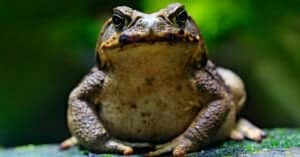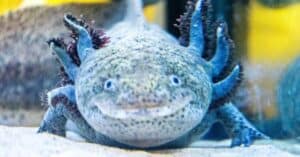Tiny Frogs: The 12 Smallest Frogs in the World
@media (min-width: 481px) {
.mobile-top-content {
display: none;
}
}
#mobileTopContentCTACarouselControls { overflow: hidden; text-overflow: ellipsis; white-space: nowrap; }
.mobile-top-content .more { color: #fff; }
.mobile-top-content a { color: #fff; text-decoration: underline; }
.mobile-top-content a:hover { color: #fff; text-decoration: underline; }
@media (max-width: 480px) {
.mobile-top-content {
background-color: #06a10b;
color: #fff;
text-align: center;
/*height: 60px;
padding-top:5px;*/
font-size:80%;
/* display: block; */
margin: 0px -30px;
}
}
Frogs are an incredibly diverse grouping of animals. While the largest frog in the world – the Goliath Frog -measures 12.5 inches, the tiniest frogs in the world measure less than one inch in length! These incredible amphibians can be smaller than the size of a human fingernail!
Today we’ll talk about the twelve smallest frogs in the world. Where do they live, what do they look like, and what sets them apart from other frogs.
12. Paedophryne kathismaphlox
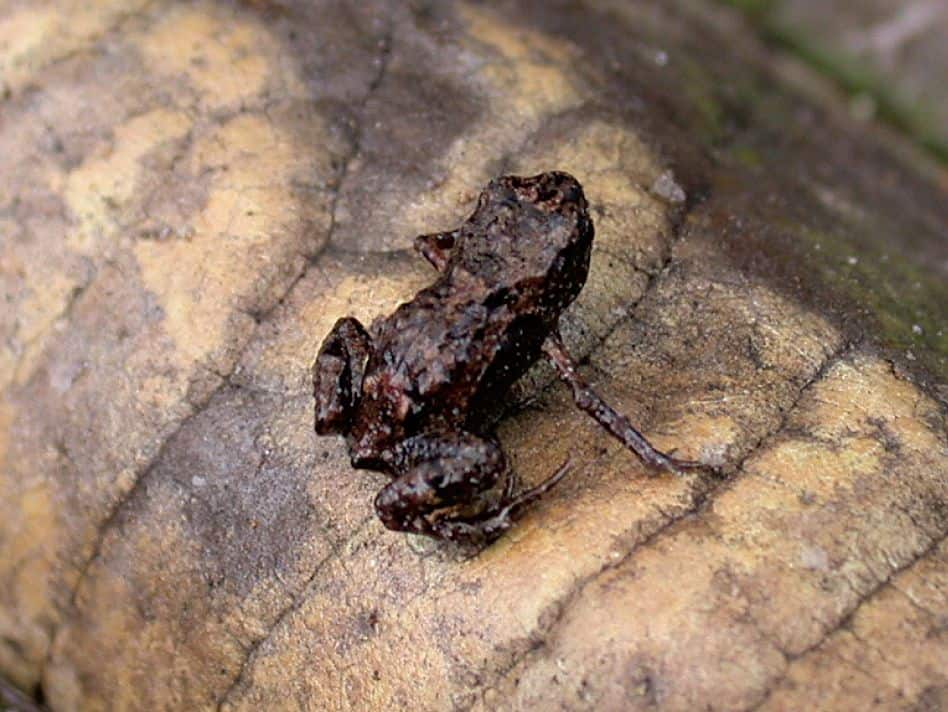
Fred Kraus / Creative Commons – License
Discovered in 2002, these frogs live in Papua New Guinea. They live in leaf litter on forest floors and are just 10.4-10.9 mm in length. They are dark brown and black in color with speckled skin.
11. Mini scule
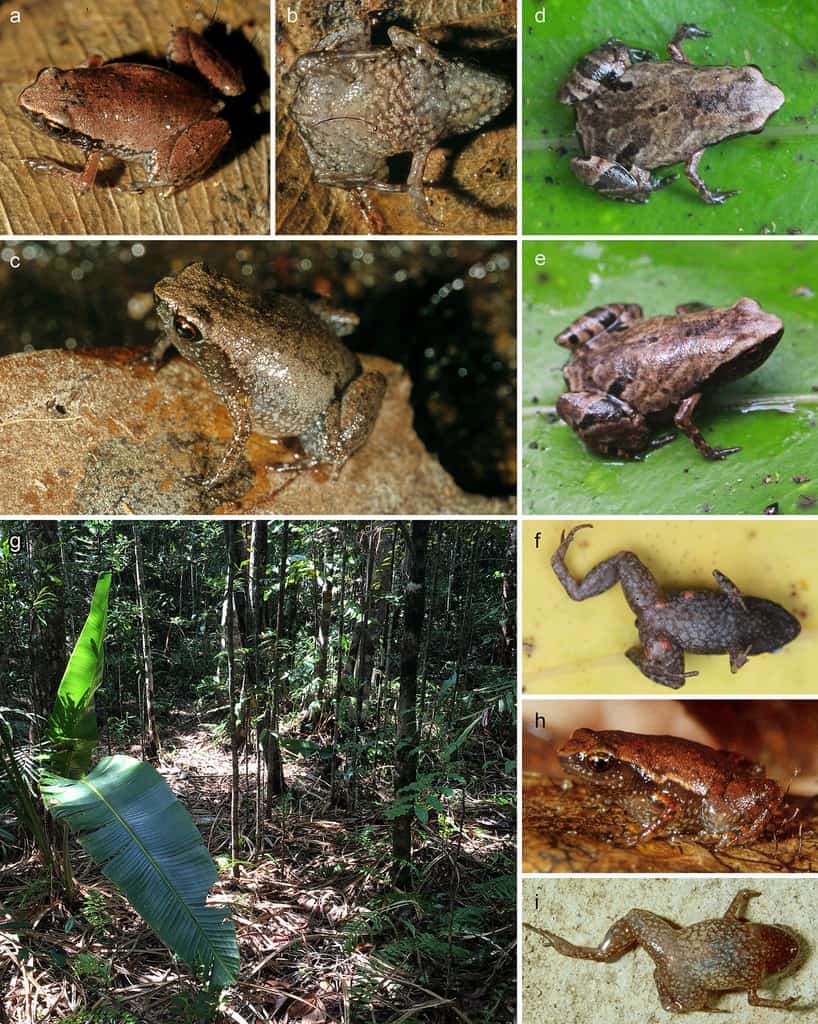
Mark D. Scherz, Carl R. Hutter, Andolalao Rakotoarison, Jana C. Riemann, Mark-Oliver Rödel, Serge H. Ndriantsoa, Julian Glos, Sam Hyde Roberts, Angelica Crottini, Miguel Vences, Frank Glaw / Creative Commons – License
These frogs have the perfect scientific names! Their name is funny and absolutely describes their teeny tiny bodies.
Measuring 8.4-10.8 mm in length, these frogs were discovered in 2004 and described scientifically in 2019. This makes them an incredibly new species.
You’ll see this pattern continue throughout our list—because these frogs are so tiny and have excellent camouflage, it took us humans a long time to notice them.
Mini scule frogs are dark brown with speckled bellies and bronze-colored markings. Their eyes are orange, and they have no teeth!
10. Stumpffia yannik
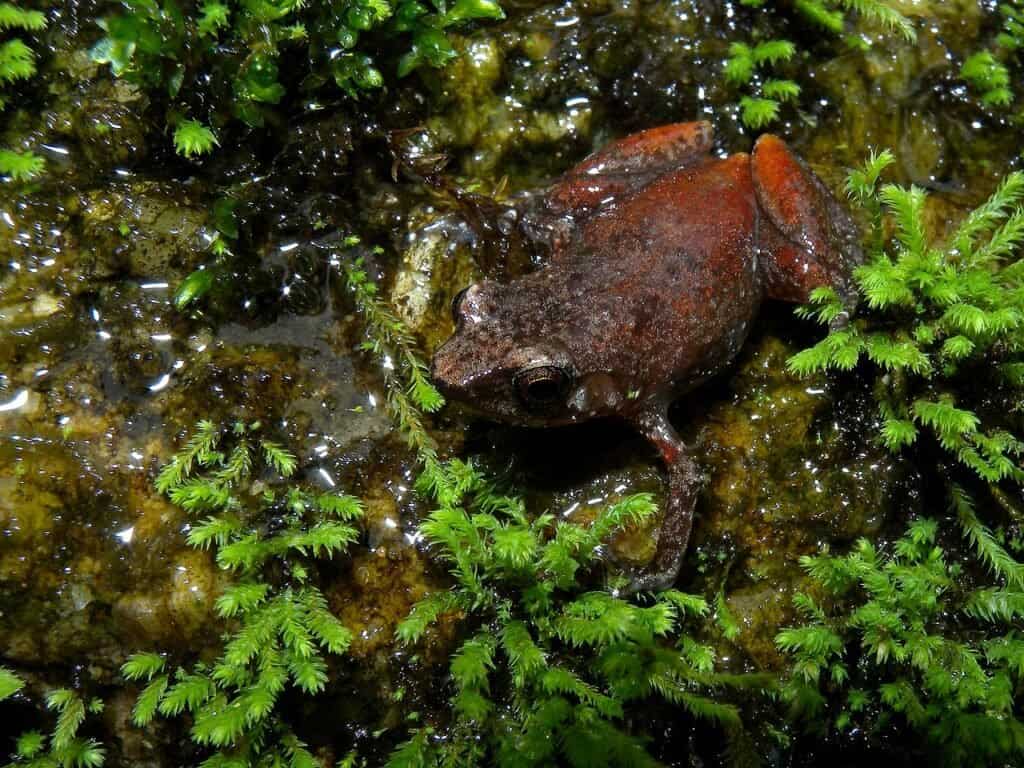
Frank Vassen from Brussels, Belgium / – License
These frogs are just 9.8-10.6 mm in length. They’re rarely spotted and their habitat in Madagascar is currently at risk. Not much is known about this species.
9. Sechellophryne gardineri
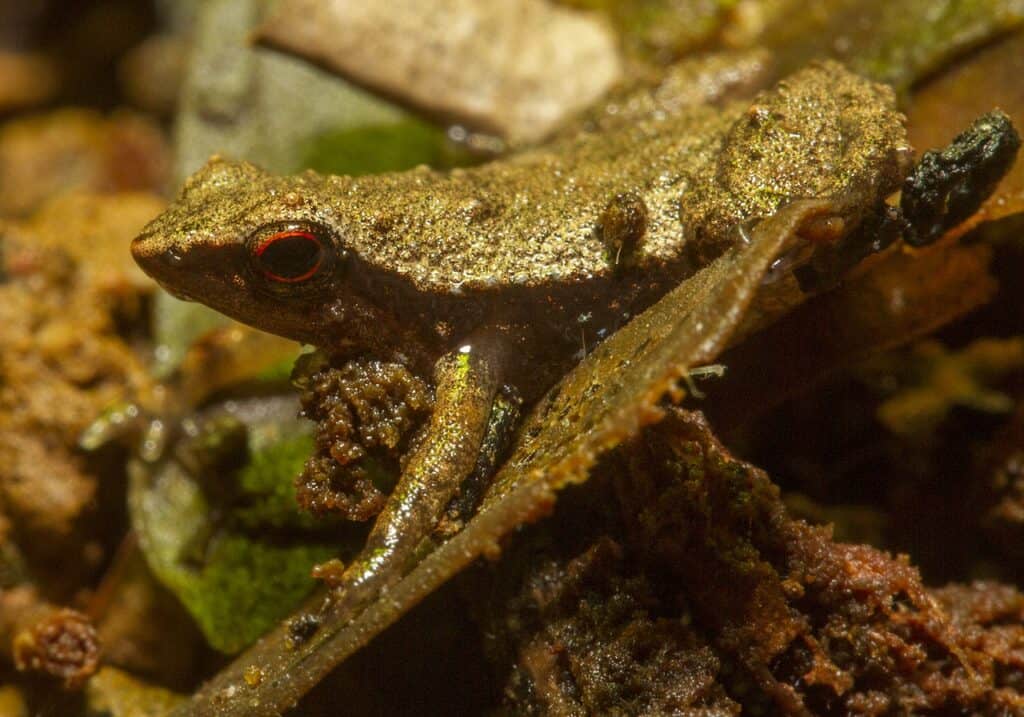
Evan Pickett / Creative Commons – License
These frogs are also known as Gardiner’s Frog, after a zoologist and oceanographer named John Stanley Gardiner.
They’re 10.1 mm in length and have brown skin with a stripe across each side. Gardiner’s Frogs live on the Mahé and Silhouette Islands.
Lacking a middle ear cavity, these frogs still seem to hear just fine! They use their mouths to transmit sound instead.
Another unique trait is that these frogs don’t go through metamorphosis, but instead hatch fully developed.
8. Eleutherodactylus Iberia

iStock.com/uba-foto
Most Eleutherodactylus species are larger, but this little frog maxes out at just 10 mm! It’s the smallest frog in the Northern hemisphere.
They are dark brown in color, with a white-yellow striped pattern that becomes more saturated near the frogs’ heads.
These frogs are also known as the Monte Iberia eleuth and Monte Iberia Dwarf Frog. They were first documented by Alberto R. Estrada.
7. Brachycephalus didactylus
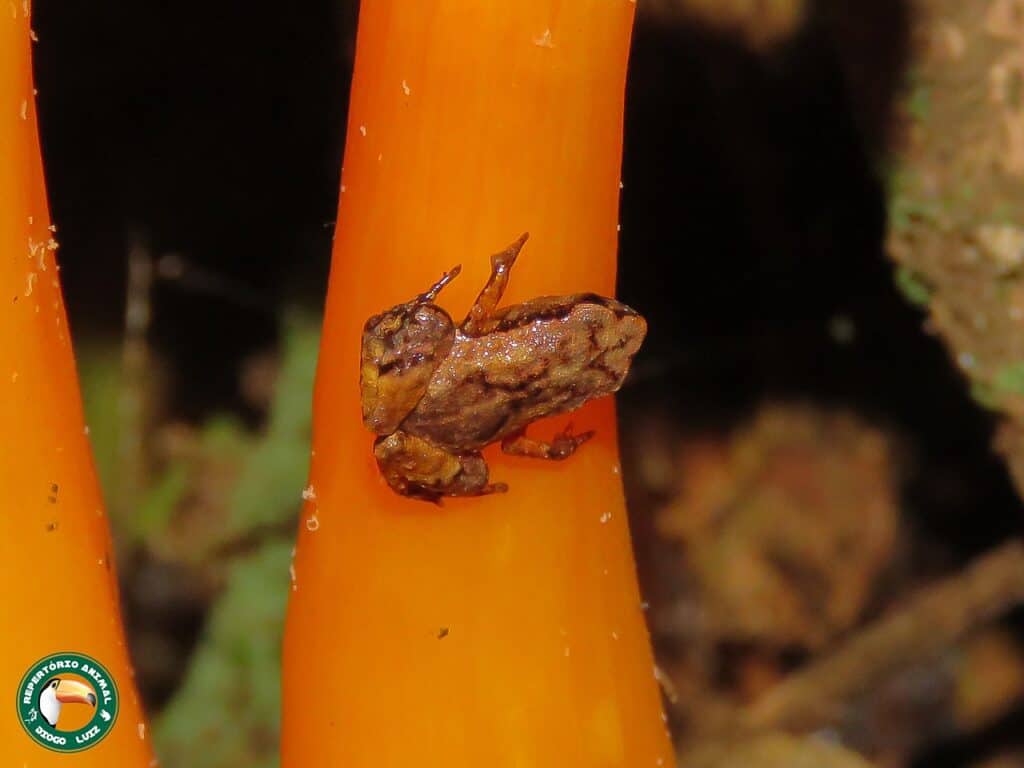
Diogo Luiz / Creative Commons – License
Also known as Izecksohn’s toad, the flea-frog, or Brazilian Gold Frog, these little guys are just 8.6-10.2 mm.
Although others in the genus are brighter in color, these frogs are patterned in varying shades of brown. The males are very aggressive, particularly during mating. They will fight to the death over a mate, even tearing out the other frog’s organs!
Females die after birthing eggs, and the males then raise the offspring.
6. Mini mum
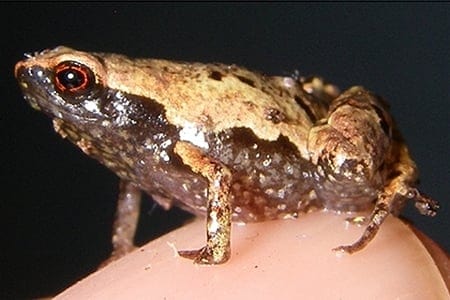
Mark D. Scherz , Carl R. Hutter, Andolalao Rakotoarison, Jana C. Riemann, Mark-Oliver Rödel, Serge H. Ndriantsoa, Julian Glos, Sam Hyde Roberts, Angelica Crottini, Miguel Vences, Frank Glaw / Creative Commons – License
Another aptly named species, you can easily guess that these frogs were documented at the same time as Mini scule. They also have a slightly larger counterpart that didn’t make this list called Mini ature. All live in Madagascar and were described scientifically in 2019.
Mini mum is just 8-10 mm. Frogs in these species have dark brown, speckled bellies, tan markings, and brightly-colored eyes.
5. Paedophryne verrucosa

Fred Kraus / Creative Commons – License
This is another rare species that we know little about. They are found in the southeast in Papua New Guinea and were discovered very recently in 2011!
The species is brown with yellow splotches and bumpy skin. The frogs grow to just 8-9 mm.
4. Paedophryne dekot

Fred Kraus / Creative Commons – License
Discovered at the same time as verrucosa, these frogs are also native to Papua New Guinea. They have smoother red-brown skin. They are 8-9 mm long.
3. Stumpffia contumelia
These cute little frogs have dark brown undersides and are bright orange at the top of their bodies with darker speckles. Their eyes are large, round, and orange.
Native to Madagascar, this species was discovered in 2017! They measure 8-9 mm.
2. Paedophryne swiftorum
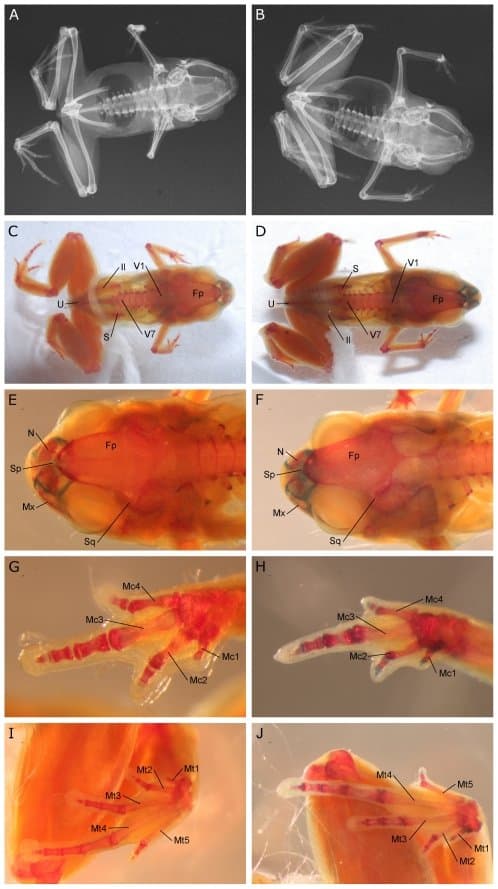
Rittmeyer E, Allison A, Gründler M, Thompson D, Austin C / Creative Commons – License
Can you believe the frogs on this list continue to get smaller? The swiftorum species maxes out at just 8.5 mm.
Their skin is a milky color with dark markings and specks of orange. Their eyes are bright orange as well. The frogs were initially discovered in 2008 in Papua New Guinea.
They chirp to attract a mate, sounding so much like crickets that they were mistaken as just that at first! Then, Cornell University student Michael Gründler discovered the tiny frog hidden in the leaf litter.
1. Paedophryne amanuensis
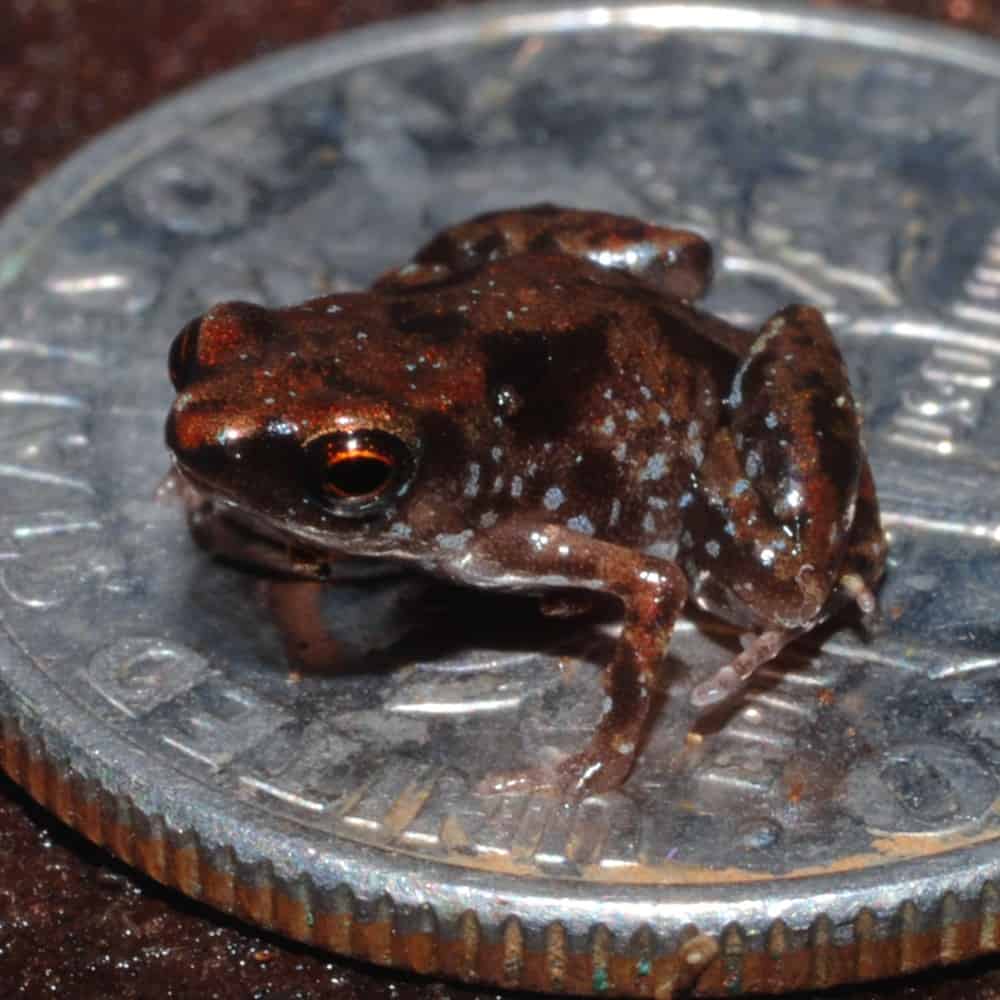
Rittmeyer EN, Allison A, Gründler MC, Thompson DK, Austin CC / Creative Commons – License
Finally, we have the number one smallest frog in the world! They are just 7.7 mm in length, and are a dark reddish brown with silvery-colored markings. Their eyes are orange.
Like the rest of its genus, these frogs are native to Papua New Guinea. They were discovered in 2012 by Christopher Austin and Eric Rittmeyer, who found the frogs by scooping clumps of leaf litter into baggies!
What do the World’s Smallest Frogs Eat?
At such small sizes, these frogs can’t eat the same as your typical frog. Instead, they eat very small insects such as mites. They surely get full a lot faster than larger frogs, too, allowing them to survive off of the food sources that larger predators ignore.
Are There Even Smaller Frogs Out There?
So many of these frogs have been found in recent years, it begs the question: are there more miniature frogs waiting to be discovered?
Maybe so! It can be quite difficult to discover new species because these frogs camouflage very well. They also tend to hide in areas such as littered forest floors, so one might pass by without even seeing them!
It all truly makes you wonder what else is out there that we’re missing—will we ever really find the smallest frog in the world, or is it in hiding even still?
More from A-Z Animals
.more-snake-card-image { max-height:140px !important; }
@media (min-width: 481px) {
.mobile-top-content {
display: none;
}
}
#mobileTopContentCTACarouselControls { overflow: hidden; text-overflow: ellipsis; white-space: nowrap; }
.mobile-top-content .more { color: #fff; }
.mobile-top-content a { color: #fff; text-decoration: underline; }
.mobile-top-content a:hover { color: #fff; text-decoration: underline; }
@media (max-width: 480px) {
.mobile-top-content {
background-color: #06a10b;
color: #fff;
text-align: center;
/*height: 60px;
padding-top:5px;*/
font-size:80%;
/* display: block; */
margin: 0px -30px;
}
}
Frogs are an incredibly diverse grouping of animals. While the largest frog in the world – the Goliath Frog -measures 12.5 inches, the tiniest frogs in the world measure less than one inch in length! These incredible amphibians can be smaller than the size of a human fingernail!
Today we’ll talk about the twelve smallest frogs in the world. Where do they live, what do they look like, and what sets them apart from other frogs.
12. Paedophryne kathismaphlox

Fred Kraus / Creative Commons – License
Discovered in 2002, these frogs live in Papua New Guinea. They live in leaf litter on forest floors and are just 10.4-10.9 mm in length. They are dark brown and black in color with speckled skin.
11. Mini scule

Mark D. Scherz, Carl R. Hutter, Andolalao Rakotoarison, Jana C. Riemann, Mark-Oliver Rödel, Serge H. Ndriantsoa, Julian Glos, Sam Hyde Roberts, Angelica Crottini, Miguel Vences, Frank Glaw / Creative Commons – License
These frogs have the perfect scientific names! Their name is funny and absolutely describes their teeny tiny bodies.
Measuring 8.4-10.8 mm in length, these frogs were discovered in 2004 and described scientifically in 2019. This makes them an incredibly new species.
You’ll see this pattern continue throughout our list—because these frogs are so tiny and have excellent camouflage, it took us humans a long time to notice them.
Mini scule frogs are dark brown with speckled bellies and bronze-colored markings. Their eyes are orange, and they have no teeth!
10. Stumpffia yannik

Frank Vassen from Brussels, Belgium / – License
These frogs are just 9.8-10.6 mm in length. They’re rarely spotted and their habitat in Madagascar is currently at risk. Not much is known about this species.
9. Sechellophryne gardineri

Evan Pickett / Creative Commons – License
These frogs are also known as Gardiner’s Frog, after a zoologist and oceanographer named John Stanley Gardiner.
They’re 10.1 mm in length and have brown skin with a stripe across each side. Gardiner’s Frogs live on the Mahé and Silhouette Islands.
Lacking a middle ear cavity, these frogs still seem to hear just fine! They use their mouths to transmit sound instead.
Another unique trait is that these frogs don’t go through metamorphosis, but instead hatch fully developed.
8. Eleutherodactylus Iberia

iStock.com/uba-foto
Most Eleutherodactylus species are larger, but this little frog maxes out at just 10 mm! It’s the smallest frog in the Northern hemisphere.
They are dark brown in color, with a white-yellow striped pattern that becomes more saturated near the frogs’ heads.
These frogs are also known as the Monte Iberia eleuth and Monte Iberia Dwarf Frog. They were first documented by Alberto R. Estrada.
7. Brachycephalus didactylus

Diogo Luiz / Creative Commons – License
Also known as Izecksohn’s toad, the flea-frog, or Brazilian Gold Frog, these little guys are just 8.6-10.2 mm.
Although others in the genus are brighter in color, these frogs are patterned in varying shades of brown. The males are very aggressive, particularly during mating. They will fight to the death over a mate, even tearing out the other frog’s organs!
Females die after birthing eggs, and the males then raise the offspring.
6. Mini mum

Mark D. Scherz , Carl R. Hutter, Andolalao Rakotoarison, Jana C. Riemann, Mark-Oliver Rödel, Serge H. Ndriantsoa, Julian Glos, Sam Hyde Roberts, Angelica Crottini, Miguel Vences, Frank Glaw / Creative Commons – License
Another aptly named species, you can easily guess that these frogs were documented at the same time as Mini scule. They also have a slightly larger counterpart that didn’t make this list called Mini ature. All live in Madagascar and were described scientifically in 2019.
Mini mum is just 8-10 mm. Frogs in these species have dark brown, speckled bellies, tan markings, and brightly-colored eyes.
5. Paedophryne verrucosa

Fred Kraus / Creative Commons – License
This is another rare species that we know little about. They are found in the southeast in Papua New Guinea and were discovered very recently in 2011!
The species is brown with yellow splotches and bumpy skin. The frogs grow to just 8-9 mm.
4. Paedophryne dekot

Fred Kraus / Creative Commons – License
Discovered at the same time as verrucosa, these frogs are also native to Papua New Guinea. They have smoother red-brown skin. They are 8-9 mm long.
3. Stumpffia contumelia
These cute little frogs have dark brown undersides and are bright orange at the top of their bodies with darker speckles. Their eyes are large, round, and orange.
Native to Madagascar, this species was discovered in 2017! They measure 8-9 mm.
2. Paedophryne swiftorum

Rittmeyer E, Allison A, Gründler M, Thompson D, Austin C / Creative Commons – License
Can you believe the frogs on this list continue to get smaller? The swiftorum species maxes out at just 8.5 mm.
Their skin is a milky color with dark markings and specks of orange. Their eyes are bright orange as well. The frogs were initially discovered in 2008 in Papua New Guinea.
They chirp to attract a mate, sounding so much like crickets that they were mistaken as just that at first! Then, Cornell University student Michael Gründler discovered the tiny frog hidden in the leaf litter.
1. Paedophryne amanuensis

Rittmeyer EN, Allison A, Gründler MC, Thompson DK, Austin CC / Creative Commons – License
Finally, we have the number one smallest frog in the world! They are just 7.7 mm in length, and are a dark reddish brown with silvery-colored markings. Their eyes are orange.
Like the rest of its genus, these frogs are native to Papua New Guinea. They were discovered in 2012 by Christopher Austin and Eric Rittmeyer, who found the frogs by scooping clumps of leaf litter into baggies!
What do the World’s Smallest Frogs Eat?
At such small sizes, these frogs can’t eat the same as your typical frog. Instead, they eat very small insects such as mites. They surely get full a lot faster than larger frogs, too, allowing them to survive off of the food sources that larger predators ignore.
Are There Even Smaller Frogs Out There?
So many of these frogs have been found in recent years, it begs the question: are there more miniature frogs waiting to be discovered?
Maybe so! It can be quite difficult to discover new species because these frogs camouflage very well. They also tend to hide in areas such as littered forest floors, so one might pass by without even seeing them!
It all truly makes you wonder what else is out there that we’re missing—will we ever really find the smallest frog in the world, or is it in hiding even still?

